Lion850
National Hazard
   
Posts: 514
Registered: 7-10-2019
Location: Australia
Member Is Offline
Mood: Great
|
|
Extracting copper and nickel from a coin
This was discussed at length in a long-running sciencemadness threat called “Separation of a US nickel” that ran over 11 pages from 2011 to 2018:
http://www.sciencemadness.org/talk/viewthread.php?tid=16811&...
Taking the copper iodide route was discussed, but I am not sure if anyone actually tried it. So I wanted to give it a go.
Starting point was Australian 50c coins, which is said to be made from 75% copper and 25% nickel. One coin weights 15.5g (on my scale) and should thus
contain 11.6g copper and 3.9g nickel.
The coin was placed in a 400ml beaker and 70% nitric acid added in stages. See photo. Lots of NO2 fumes! By the end of the day 90g was added which was
slight excess. The next morning the coin was completely gone and there was a very dark green-blue solution. See photo.
I wanted to minimize the acid leftover in solution so added 3 x 5c coins, these are small and weighed 8.7g in total. After a few hours with some
heating there was no more reaction. The undissolved pieces were removed the weighed at 3.2g. Thus, some 21g of coin went into solution.
I wanted to use just part of the solution so I could try more then once, so I decanted off one third by weighing the total solution and then pouring
off until the weight reduced by a third. This was now my working solution and should have contained 5,25g copper and 1.75g nickel. This solution was
diluted with 20ml water.
The next step was to try and ppt the copper as copper iodide. 20g potassium iodide was dissolved in 30ml water, this should have been enough to
perform a displacement with the copper nitrate as well as the nickel nitrate.
When I previously made copper iodide CuI by reacting CuSO4 and KI I did not use a reducer which resulted in free iodine and a lower yield of CuI (and
the product had to be well washed with ethanol to remove all the free copper). This time I use sodium thiosulphate as the reducing agent. Atomistry
described such a reaction (with relevant weights) but using copper sulphate, not copper nitrate. I was not sure exactly which other products would
form and thus could not work out the stoichiometric amount of sodium thiosulphate to use. I simply used a similar weight ratio for the KI/Na2S2O3 as
Atomistry mentioned meaning that with my 20g KI I had to use 28g Na2S2O3. This was dissolved in 40ml water (took a bit of heating to get it
dissolved).
Question: Is this more or less the correct amount of Na2S2O3? Woelen previously suggested using sodium metabisulfite Na2S2O5 for this purpose, would
it have been a better choice than the Na2S2O3?
The sodium thiosulfate was added to the nitrate solution with stirring. A lime green suspension formed, and I though the experiment was ruined. The KI
was then slowly added, and I was happy to see the pale brown color similar to me previous CuI. And happily there was no sign of free iodine. After
some stirring the solution was vacuum filtered. The remainder wet was a slightly yellowish white. See photo. The filtrate was light green, which is a
color that pointed to nickel. This was the end of the day.
The next morning the (suspected) CuI remainder was washed with ethanol to check for free iodine, but the ethanol wash water stayed completely clear.
The product was then tried a few hours on a steam bath until the weight remained the same. The final weight was 15.8g, which was just about exactly
what was the theoretical CuI yield from 5.25g of copper. See photo of the CuI from the coin next to the CuI from CuSO4; it looks very similar but the
coin CuI is slightly darker. But I saw later it reacts different!
The filtrate that was light green became brown overnight! Filtering brought it back to light green, and showed that the brown suspension was a very
small quantity of powder (a fraction of a gram) ; it was so little that it was not even possible to scrape it off the filter paper. I do not know what
this compound was, but I saw that if I left the green solution stand more of this brown suspended powder formed.
I then added 4g NaOH dissolved in 10ml of water to the green solution, hoping that any nickel salt will be ppt out as nickel hydroxide. A light green
suspension quickly formed, which became darker and more olive green. The solution was vacuum filtered, and the remained washed twice in the filter
with water. The wet weight was 19g!
The product was dried in the steam bath, see photo. The weight was checked every few hours. The product kept losing weight until after many hours of
drying in the steam bath a final weight of 3.4 gram was reached. The dry product was dark green, see photo.
I think the product is nickel hydroxide Ni(OH)2 but 1.75g nickel should have given only 2.6g hydroxide and I got 3.4, Although it is difficult to be
sure when working with such small quantities.
At this point I was reasonably happy I managed to separate the copper and nickel but wanted to do some basic tests on the products.
Suspected nickel hydroxide Ni(OH)2: A small qty was reacted with 70% HNO3 in a test tube. It quickly dissolved to give a green solution which was
expected, but at the same time NO2 fumes was seen – I did not think a normal oxide or hydroxide will do that with nitric acid? See photo.
Suspected copper iodide: A series of tests were done with both the coin CuI and the previously made CuSO4 CuI to see if they react the same:
1) With 35% H2O2 (being dropped onto a small qty of product:
CuSO4 derived CuI: Goes black from iodine release, small bubbling,
Coin CuI: Same reaction but more vigorous, to the point where it gets hot enough to start gassing off the iodine.
The test was repeated with the same result, so with H2O2 the coin CuI seems more active.
2) With 95% HsSO4 being dropped on:
CuSO4 derived CuI: Acid slowly goes brown, small bubbles, warm.
Coin CuI: Acid quickly goes black, small bubbles, warm. So again it seems more reactive.
3) With 70% HNO3 being dropped on:
With both iodides the HNO3 turns black and releases NO2, but once again a bit more vigorous with the coin CuI.
4) With 33% HCl being dropped on:
CuSO4 derived CuI: Acid turns yellow, then brown, no smell of chlorine.
Coin derived CuI: Nothing seems to happen! He CuI powder just seems to stay suspended in the HCl without any change to the acid.
I repeated this test with HCl 3 times, same result.
How can this be explained? It must be a copper and iodine compound, but something other than only CuI? I must also mention that after I first filtered
off the suspected copper iodide , the filtrate was crudely tested for presence of a iodide by mixing a sample with lead nitrate. No lead iodide ppt
formed, which made me wonder what happened to the excess KI.
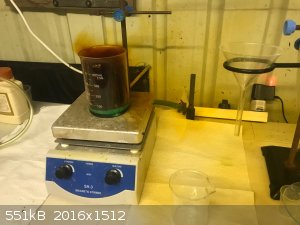 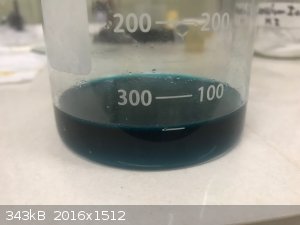 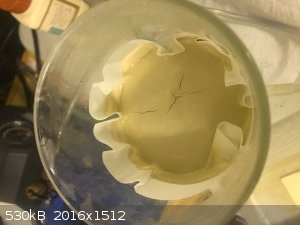 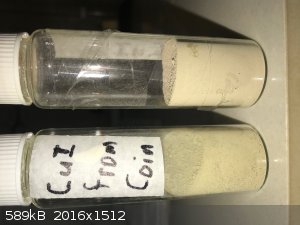 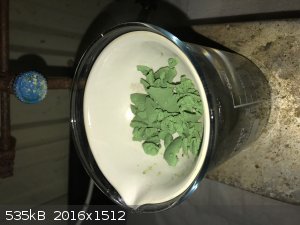 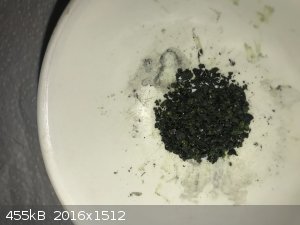 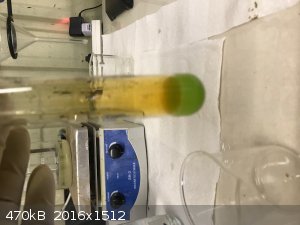
|
|
|
unionised
International Hazard
    
Posts: 5102
Registered: 1-11-2003
Location: UK
Member Is Offline
Mood: No Mood
|
|
I'm fairly sure that, like AgI, CuI will dissolve in a solution of Na2S2O3
|
|
|
AJKOER
Radically Dubious
    
Posts: 3026
Registered: 7-5-2011
Member Is Offline
Mood: No Mood
|
|
Now try a simple reagent friendly inexpensive battery cell approach.
Add dilute chlorine bleach (NaOCl with NaCl) to a microwavable vessel containing your Ni/Cu coin (acting as the anode) and a solid high surface area
carbon source (graphite rods from pencils refills, or burnst coconut shell,...., or even very very overdone toast).
Jumpstart in a microwave and reheat as needed.
Note: The electrosynthesis proceeds more rapidly with a solid coin (low surface area) relative to a high area cathode (carbon). Also, dissolving the
coin will likely be very protracted in time, so I suggest a test run by taking a small piece of the coin, as per the properties of electrochemistry,
the copper is 1st consumed and then the nickel.
You now have some CuO and NiO upon isolating and washing in distilled water. I would separate out the CuO with NH3/O2 or 3% H2O2 treatment (also
electrochemical in nature, see https://onlinelibrary.wiley.com/doi/abs/10.1002/bbpc.1963067... where the amount of ammonia employed is limited to four times the expected moles
of Cu in the Ni/Cu sample).
You want to convert the final nickel oxide into nano-NiO following a path employed (for ZnO (see https://ninithi.wordpress.com/2015/08/06/make-your-own-photo... ).
Now react it with an acid of your choice to prepare Nickel salts (or, try repeating a similar electrosynthesis approach with an anode of NiO and a
weak acid that normally, lack of extreme conditions, does not react with NiO).
CAUTION: Forget this suggested path as if very successful, and you are prone to any of these conditions, namely:
> Excessive regret for wasting time, money, and a possibly reduced life span for unnecessary exposure to corrosive, toxic, and expensive chemicals.
> You are easily depressed when you realized you have been acting unwisely (aka, an idiot).
> Given to excessive rage for being taken advantage of.
> You have a fragile ego, and now think excessively highly of your chemical prowess.
> Minor amounts of all of the above.
[Edited on 2-5-2020 by AJKOER]
|
|
|
draculic acid69
International Hazard
    
Posts: 1371
Registered: 2-8-2018
Member Is Offline
|
|
That's quite a disclaimer there ajoker.
|
|
|
Bedlasky
International Hazard
    
Posts: 1219
Registered: 15-4-2019
Location: Period 5, group 6
Member Is Offline
Mood: Volatile
|
|
CuI doesn't react with HCl. Your CuI from CuSO4 probably contain some iodine.
Na2S2O5 is better because Na2S2O3 slowly decomposes in to sulfur and also forms really strong complex with Cu(I). Thiosulfates dissolve even very
insoluble Cu(I) and Ag(I) compounds.
Your Ni(OH)2 probably contain some reducing agent, maybe NiS2O3?
You can not dehyrate fully Ni(OH)2. It will always contain some water in it's structure. If you want to fully dehydrate it, you must roast it to form
NiO.
|
|
|
fusso
International Hazard
    
Posts: 1922
Registered: 23-6-2017
Location: 4 ∥ universes ahead of you
Member Is Offline
|
|
Why not 10 5c coins instead of 1 50c at the start? 10 5c has more metal than 1 50c and also more surface area.
|
|
|
Lion850
National Hazard
   
Posts: 514
Registered: 7-10-2019
Location: Australia
Member Is Offline
Mood: Great
|
|
Quote: Originally posted by Bedlasky  | CuI doesn't react with HCl. Your CuI from CuSO4 probably contain some iodine.
Na2S2O5 is better because Na2S2O3 slowly decomposes in to sulfur and also forms really strong complex with Cu(I). Thiosulfates dissolve even very
insoluble Cu(I) and Ag(I) compounds.
Your Ni(OH)2 probably contain some reducing agent, maybe NiS2O3?
You can not dehyrate fully Ni(OH)2. It will always contain some water in it's structure. If you want to fully dehydrate it, you must roast it to form
NiO. |
Thank you for the valuable comments. I think you are spot on about the older CuI containing a small amount of free I2 by now. It still looks the same
but is stored in a clear vial so there will be slow release of I2.
Also thanks for all the other comments from everyone. Next I want to see if isocyanuric acid can provide another way to drop out a copper salt from a
mixed nitrate solution.
|
|
|
|